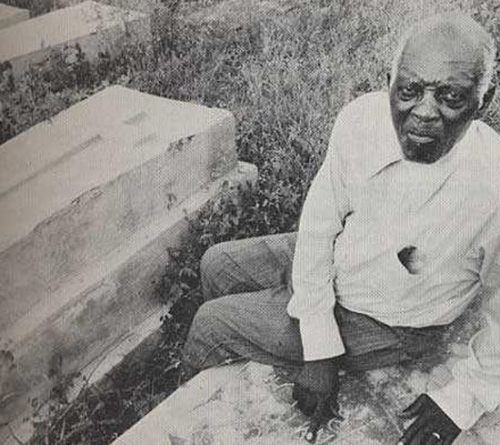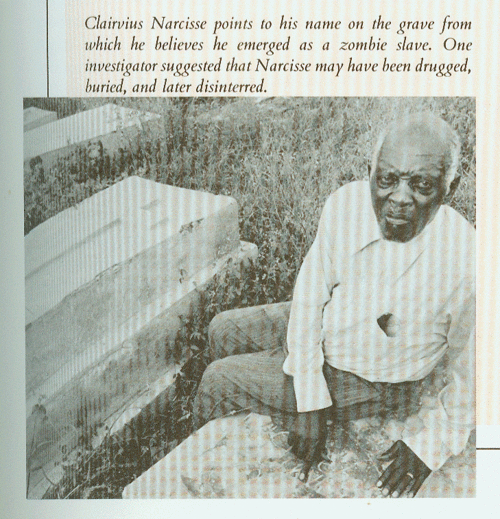Nationality Haiti Citizenship Haitian | Name Clairvius Narcisse Died 1964, Haiti | |
 | ||
Born c. 1922 L'Estere Known for Allegedly being a zombie | ||
Zombies when the dead walk clairvius narcisse
Clairvius Narcisse (c. 1922 – 1964) was a Haitian man said to have been turned into a zombie by a Haitian vodou preparation, purportedly a combination of psychoactive substances (often times the paralyzing pufferfish venom and the strong deliriant Datura). The single greatest proponent of this possibility was a graduate student in ethnobotany at Harvard University, Wade Davis, who published two popular books based on his travels and ideas during and immediately following his graduate training. Subsequent scientific examinations (using tools of analytical chemistry alongside critical review of earlier reports) have failed to support the presence of a key, claimed pharmacologically active ingredient of the preparations (tetrodotoxin), that was central to the phenomena and mechanism reported by Wade. No further supporting evidence has appeared.
Contents
- Zombies when the dead walk clairvius narcisse
- The man who was turned into a real life zombie clairvius narcisse
- Overview
- Account
- Account regarding tetrodotoxin
- References

The man who was turned into a real life zombie clairvius narcisse
Overview

Based on the presumption that tetrodotoxin and related toxins are not always fatal, but at near-lethal doses can leave a person in a state of near-death for several days with the person remaining conscious, tetrodotoxin has been alleged to result in zombieism, and has been suggested as an ingredient in Haitian Vodou preparations. This idea appeared early, in the 1938 non-fiction book Tell My Horse by Zora Neale Hurston—reporting multiple accounts of purported tetrodotoxin poisoning in Haiti, by a Bokor (voodoo sorcerer)—and popularized by Harvard-trained ethnobotanist Wade Davis, but has been dismissed by the scientific community since the 1990s based on analytical chemistry-based tests of multiple preparations and review of earlier reports (see below).
Account

After various anthropologic investigations of "zombie" stories in various cultures—including Narcisse and a handful of others—reports appeared that Narcisse received a dose of a chemical mixture containing tetrodotoxin (a pufferfish toxin) and bufotoxin (a toad toxin) to induce a coma that mimicked the appearance of death. He was then allowed to return to his home where he collapsed, "died", and was buried.

The Canadian ethnobotanist Wade Davis, who did research related to the implication that tetrodotoxin was present, hypothesized how this might have been done. The bokor (sorcerer) would have given Narcisse a powder containing the tetrodotoxin through abraded skin. Narcisse would then have fallen into a comatose state, closely resembling death, which resulted in his live burial. His body was then recovered and he was given doses of Datura stramonium to create a compliant zombie-like state and set to work on a plantation. After two years, the plantation owner died and Narcisse simply walked away to freedom.

According to Davis, Narcisse came home to his village after 18 years of being assumed dead. He was able to convince a few villagers and his sister that he was indeed who he said he was. This case puzzled many doctors because his death was documented and "verified" by the testimonies of two American doctors. The case of Narcisse argued to be a verifiable example the transformation of an individual into a zombie, and the first such case.

It has been further argued that Narcisse had broken one of the traditional behavioural codes and was made into a "zombie" as a punishment; when questioned, Narcisse told investigators that the sorcerer involved had "taken his soul". The instigator of the poisoning was alleged to be his brother, with whom he had quarreled over land.
Per this account, after his apparent death and subsequent burial on May 2, 1962, his body was recovered and he was given a paste made from datura, which at certain doses has a hallucinogenic effect and can cause memory loss. The bokor who recovered him then, as stated, reportedly forced him, alongside others, to work on a sugar plantation until the master's death two years later. When the bokor died, and regular doses of the hallucinogen ceased, he eventually regained sanity and returned to his family after another 16 years. Narcisse was immediately recognized by the villagers and his family. When he told them the story of how he was dug up from his grave and enslaved, the villagers were surprised, but they accepted his story because they believed his experience resulted from the power of voodoo magic. He was seen as the man who was once a zombie.
Account regarding tetrodotoxin
While in these popular accounts, and in Haiti, tetrodotoxin is thought to have been used in voodoo preparations, in so-called zombie poisons, subsequent careful analysis has repeatedly called these accounts and early analytical studies into question on technical grounds; moreover, they have failed to identify the toxin in any such preparation, such that discussion of the matter of tetrodotoxin use in this way has all but disappeared from the primary literature since the early 1990s. Kao and Yasumoto concluded in the first of their papers in 1986 (and remained unswerving on the matter in their later work) that "the widely circulated claim in the lay press to the effect that tetrodotoxin is ... causal agent" in a "zombification process" is, in their view, "without factual foundation." Kao, of the State University of New York, on interview on the matter in 1988, stated, "I actually feel this is an issue of fraud in science," and a supporter of Wade, Bo Holmstedt of the Karolinska Institute, more restrained, stated that it was "not deliberated fraud," rather that it was "withholding negative data" and therefore "simply bad science." Davis responded formally to the charges, arguing the variability of the preparations (as cause for Kao's inability to find the toxin in any) and possible ineptitude in dissolving the toxin by the otherwise admittedly expert Kao, and speculating on the presence of "other ingredients" in the preparations to "enable transport across the blood–brain barrier" thus providing the needed "reduction of three orders of magnitude" of the amount needed to result in the claimed effects, and arguing that "only when the bokor … causes others to believe the victim is dead and then revived" do his efforts become apparent, and that only a single "success … would be sufficient to support the cultural belief in the … phenomenon." As of 1990, his critics were unpersuaded, and no literature to support the original contentions has yet appeared as of 2015, although lively popular description, especially on the web, continues.
